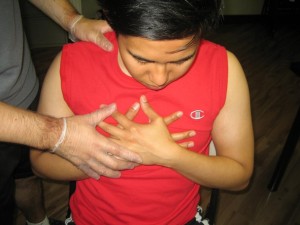A chest muscle strain involves a partial or full tear of the chest muscles. Generally, there are 2 muscles in the chest area – pectoralis major and pectoralis minor.
The function of these muscles is to help with shoulder movement such as pushing objects or moving the arm across the chest. Once these are done repeatedly, the muscles might strain or tear, resulting to a chest muscle strain. The damage can be categorized as grade 1-3 and might result to loss of function of the arm depending on the extent of the injury.

- Grade 1 – only a few muscle fibers of the chest muscles are damaged which results to mild discomfort but the functionality is not lost.
- Grade 2 – a few muscle fibers are damage which triggers significant pain and partial loss of arm function.
- Grade 3 – almost all the muscle fibers are damaged along with intense pain with full loss of arm function.
What are the causes?
One of the main causes of a chest muscle strain is abrupt impact to the muscle. This is likely to occur during activities that involve repeated heavy weightlifting or performing bench press.
In some cases, repeated movement of the arm across the chest can also strain the chest muscles. These activities can cause gradual progressive deterioration of the chest muscles resulting to injury.
What are the indications of a chest muscle strain?
If an individual has a chest muscle strain, the following are present:
- Chest pain at the front of the chest region or front part of the shoulder during activity
- Localized pain in the chest region that does not radiate to other parts of the body, except in rare instances where it can spread to the neck.
- Pain is aggravated by activity
- Pain is produced if the affected muscles are pressed
- Muscle spasms or weakness in some cases
Management
The ideal way to manage a chest muscle strain includes conservative measures such as:
- Application of ice for 15-20 minutes at 2-3 times throughout the day after the injury.
- Avoid activities that can aggravate the pain
- Pain medications including ibuprofen can be used to manage the inflammation and pain
- In rare instances involving full rupture of the chest muscle, surgery is required.
- Rehabilitation exercises can be started once the pain and inflammation has settled. The individual can gradually resume normal activities.
Quick Note / Disclaimer
The material posted on this page on a chest muscle strain is for learning and educational purposes only. To learn to recognize and manage muscular injuries, register for a first aid and CPR course with Red Deer First Aid.
